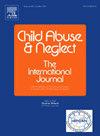The effects of perpetrator power on the duration and number of children victimized in episodes of child sexual abuse linked to a federated youth serving organization
IF 3.4
2区 心理学
Q1 FAMILY STUDIES
引用次数: 0
Abstract
Background
Qualitative research on child sexual abuse (CSA) in youth serving organizations (YSOs) indicates that powerful, high-status persons are better able to abuse children, because they have a superior capacity to obtain the acquiescence and overcome the resistance of children to their abusive advances, evade detection of their abusive behavior, and escape accountability for their detected abuse.
Objective
We conduct quantitative empirical analyses designed to confirm the presumption that powerful, high-status persons are better able to abuse children in YSOs.
Setting
We analyzed 85 episodes of CSA linked to Boys and Girls Clubs (BGCs) affiliated with the Boys and Girls Clubs of America, identified by a Hearst Connecticut reporting team.
Method
We conduct multivariate analyses that estimate the relationship between two sources of perpetrators' power and status (occupancy of a leadership position in their BGC and affiliations with other YSOs in their local BGC's community) and two public health consequences of the CSA they perpetrated (the duration of their abuse and the number of children they abused), controlling for a battery of possible confounds.
Results
Episodes of abuse perpetrated by persons who were leaders of their local BGCs victimized 1.9 more club-affiliated children than those that were perpetrated by lower-level staffers, while episodes of abuse perpetrated by persons affiliated with other YSOs in their local BGC’s community on average were 3.3 years longer and victimized 1.8 more club-affiliated children than those that were perpetrated by persons not affiliated with other YSOs.
Conclusion
YSO child safety measures, which currently focus on lower-level staffers' potential to abuse children, should be augmented to increase their focus on YSO leaders' and prominent community members' abusive potential.
在与一个联合青年服务组织有关的儿童性虐待事件中,犯罪者的权力对受害儿童的持续时间和人数的影响
背景有关青少年服务机构(YSOs)中儿童性虐待(CSA)的定量研究表明,有权势、地位高的人更有能力虐待儿童,因为他们有更强的能力获得儿童的默许并克服儿童对其施虐行为的抵制,逃避对其施虐行为的发现,以及逃避对其被发现的施虐行为的问责。我们对赫斯特康涅狄格州报告小组发现的与美国男孩女孩俱乐部下属男孩女孩俱乐部(BGCs)有关的 85 起 CSA 事件进行了分析。方法我们进行了多变量分析,估计了犯罪者的两种权力和地位来源(在其所在的 BGC 中担任领导职务以及与当地 BGC 社区中其他 YSO 的从属关系)与他们所实施的 CSA 的两种公共健康后果(虐待持续时间和受虐儿童人数)之间的关系,并对一系列可能的混杂因素进行了控制。结论目前的青少年服务组织儿童安全措施主要针对低级别工作人员虐待儿童的可能性,应加强对青少年服务组织领导者和知名社区成员虐待儿童可能性的关注。
本文章由计算机程序翻译,如有差异,请以英文原文为准。
求助全文
约1分钟内获得全文
求助全文
来源期刊

Child Abuse & Neglect
Multiple-
CiteScore
7.40
自引率
10.40%
发文量
397
期刊介绍:
Official Publication of the International Society for Prevention of Child Abuse and Neglect. Child Abuse & Neglect The International Journal, provides an international, multidisciplinary forum on all aspects of child abuse and neglect, with special emphasis on prevention and treatment; the scope extends further to all those aspects of life which either favor or hinder child development. While contributions will primarily be from the fields of psychology, psychiatry, social work, medicine, nursing, law enforcement, legislature, education, and anthropology, the Journal encourages the concerned lay individual and child-oriented advocate organizations to contribute.
 求助内容:
求助内容: 应助结果提醒方式:
应助结果提醒方式:


